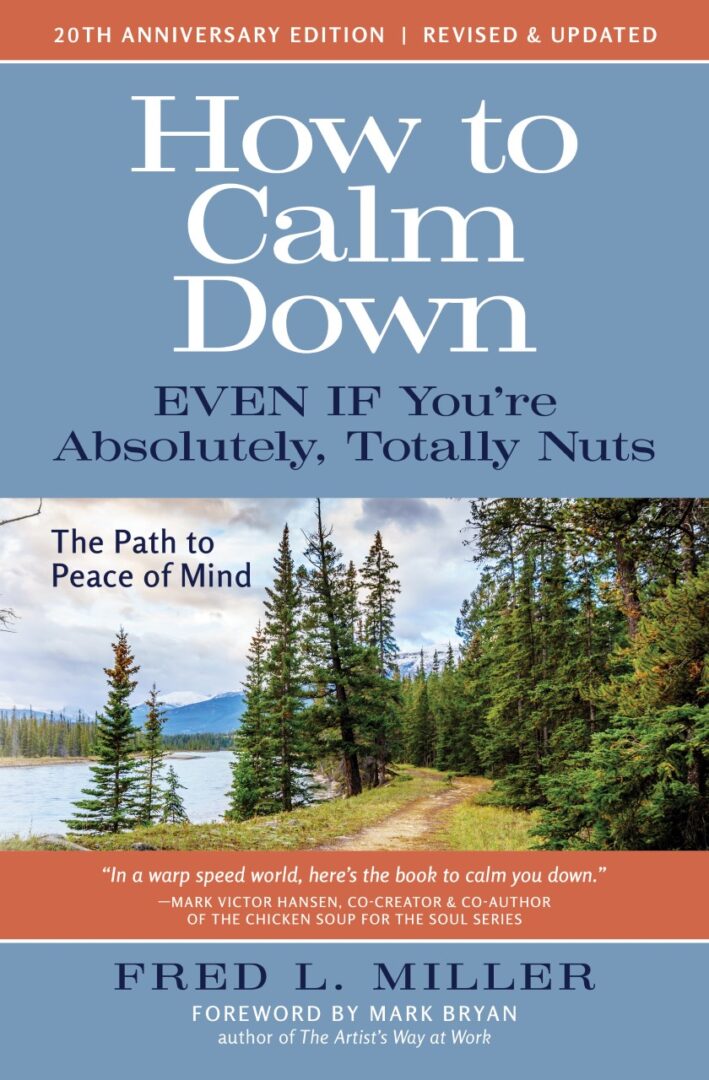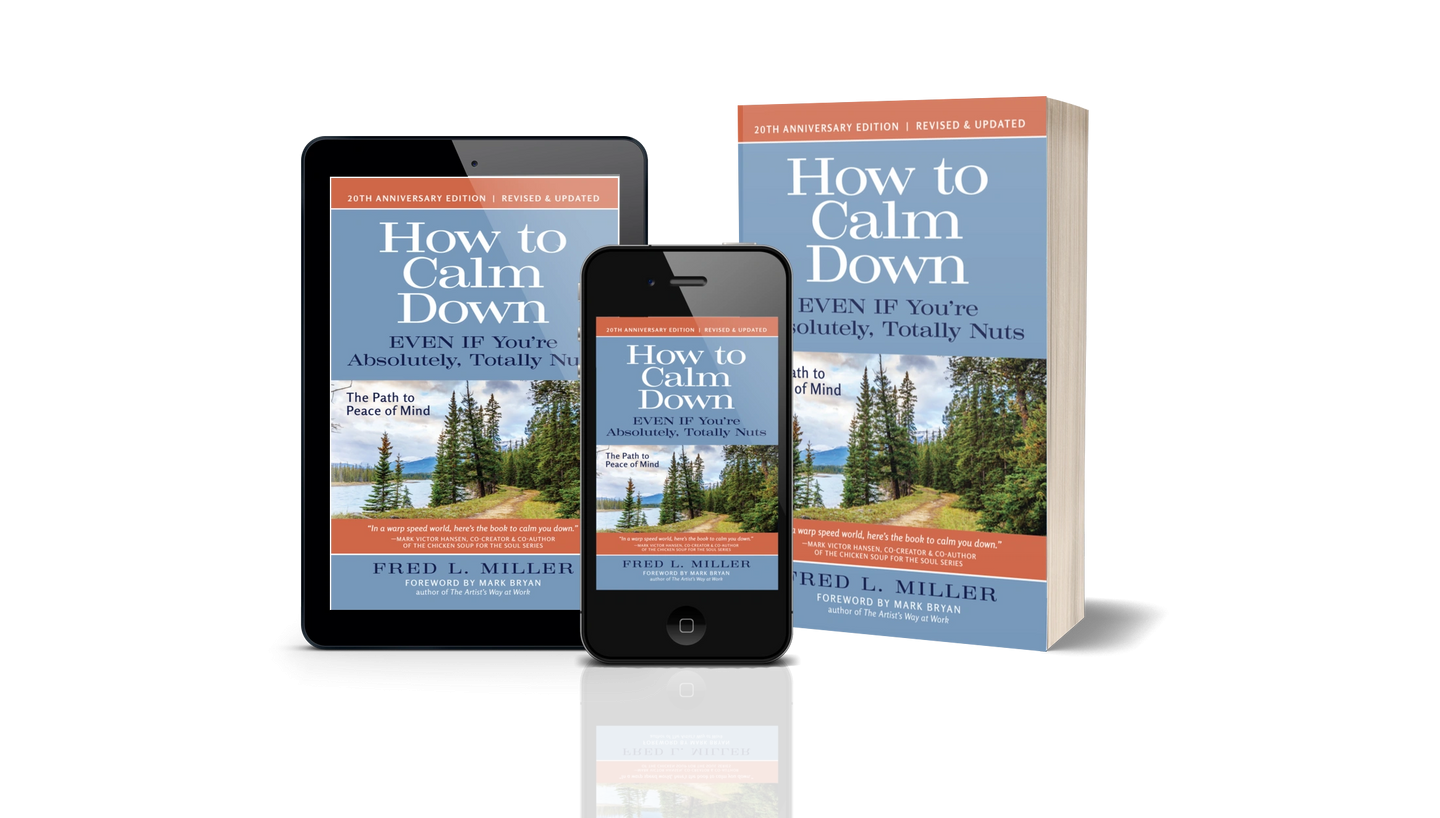
Do you really want to relax?
Don’t you work better when
you have a full head of steam?
I used to think so, but that is no longer true. I’ve learned that sometimes a full head of steam gets in my way.
You can achieve this by focusing on the moment, the Here & Now. The Buddhists call it mindfulness. Or being in the present moment or simply paying attention.
The job itself does not matter—you could be frosting a cake or hanging a picture—as long as you’re focused, but if your mind wanders, you might smash your thumb.
You can think of this relaxation stuff as preventive medicine, or you can think of it as being race-tuned, operating at your highest level.
My name is Fred, and I was nuts. I used to be absolutely totally nuts 24/7, but now not very often. I’ve been teaching How To Calm Down for more than thirty-five years. I teach cancer-support groups, in senior centers, third-year medical students, and attorneys. I’ve seen minor miracles, from a lawyer in a $2000 suit who couldn’t stop jiggling his leg, to a woman undergoing chemotherapy, with real concern about her future health, settle into the Here & Now. They learned how to live one breath at a time and have a peaceful life. You don’t have to become a Buddhist or a yogi or a hermit to learn to relax and enjoy your life. I learned, they learned, and so can you. It’s easy: you just have to do it. One breath at a time.
At any given moment during a typical day, does your blood pressure rise, your pulse rate hit 10% over normal, and your breathing seems to stop? Sound familiar?
If so, read on.
Once upon a time, I worked in a New York City advertising agency. Some days between the workload, the personalities, and the office politics, by midday I was absolutely, totally nuts. To relax at lunch, I went to a Midtown restaurant for a couple of beers and a cheeseburger. The beer solution worked. I calmed down. I was ready to face the second half of my day. After two months, however, I had put on weight. My pants were too tight and I felt terrible. I knew I had to cut out the two bottles of beer but I didn’t know how to calm down without them. I then began asking other people how to relax. They told me to go to Las Vegas. Go fishing. Get a date. None of these ideas would have helped me during my lunch hour.
Other people’s solutions were good for them, but not for me. I started noticing what I did when I was trying to calm down. Having abandoned the two-beer plan, I smoked a cigarette, which seemed to help, though initially, I could not figure out why. Smoking, it turned out, was an abbreviated version of my first beer at the restaurant. First, I stopped what I was doing at the time—that is, I took a break. Next, my attention shifted from the jumble of thoughts racing through my mind to the one simple action of lighting a cigarette and taking a deep breath. Ahhh, relaxation.
All I was looking for when I began my quest for relaxation was peace of mind. I was frazzled. I wasn’t running my life; instead, it was running me. I was the proverbial hamster scooting along as fast as I could on the Wheel of Life and never getting anywhere. I needed a break.
What I found was much more than that. When I began to practice relaxation, my life began to change. I slowly stopped needing outside things and became more productive. Sometimes in my life, I have been fearful of new people or unfamiliar situations. Now I have developed more faith and confidence in myself, so much so that my outlook on life turned from negative to positive. Although I remain convinced that fear is part of the human condition, by regularly practicing relaxation, I found a way not to be stopped by fear but rather to move through it. Best of all, in learning to quiet my mind, I came upon a calmness deep within me. Reaching into that calmness, I could hear the voice of my true self, which is in tune with all things in the world—maybe even in the universe. In other words, I discovered that relaxation brings about a sense of well-being and contentment.
Finding an enjoyable approach to relaxation was not easy, however, especially since I had never stuck long with anything I didn’t like. I had to sift through a lot of styles that didn’t work before finding one that did. After reading dozens of books and attending twice as many seminars on relaxation and stress management, I borrowed some methods and invented others. Then I synthesized the most effective ones into a series of short exercises, which you will find in the pages of this book.
If your partner, child, best friend, or doctor has been harping at you to calm down and relax, or if you yourself have been feeling the need for more serenity, then you will undoubtedly find some of these exercises helpful. They may even inspire you to want to relax. Best of all, you can practice them anywhere, even while sitting back in your easy chair.
You’ve even heard the announcement from the airline flight attendant, “If the oxygen masks deploy, if you are traveling with a child, put on your mask first, then assist the child.”
Get it? You can’t help others before you have taken care of yourself. In our case, it means setting up a simple routine that keeps us mentally race-tuned for peak performance.
YOUR PEAK PERFORMANCE REQUIRES CLEAR, FOCUSED THINKING.
Now, here is the Secret!
Would you like to feel better in less than ten seconds? If so, try the following exercise, called “Three Slow Breaths.”
As you do, keep your eyes open, and don’t stop reading.
Inhale.
Now exhale.
Feels good, doesn’t it?
Don’t stop reading.
On your next breath, take a deeper inhale.
Hold it and count to one.
Make this exhale a little longer than you usually do. Stop at the end of this exhale and count one.
Next, inhale even a little more deeply than last time.
Hold the inhale for two counts.
Very slow exhale this time.
Hold after exhaling for two counts.
Now return to normal breathing.
What just happened?
You stopped worrying for ten seconds! Your concentration was on your breath, which keeps you in the present moment. For those ten seconds you were Here & Now. You were not reliving a fearful experience from the past nor were you projecting into a future in which that fear would repeat. With your attention on your breath, you were experiencing the power of the present moment. For ten seconds you were not worried about losing your job, a sick relative, your child’s report card, or the day you will die. You were in the present moment. Here & Now.
Welcome to peace of mind and to the presence of mind.
Welcome to a state of fearlessness.
If you’re anything like me, you scan the table of contents looking for the chapter that tells you how it’s done, the secrets, the answers, and the keys to the kingdom. Why? Because you want answers now!
So there’s your answer. Now you know how to calm down and how to use three slow breaths to bring peace of mind. Good news–this breath exercise will work for you anywhere, at any time.
Try doing it ten times in the next twenty-four hours—at work, on the phone, in the so-called express lane at the supermarket, in traffic, in an elevator, at a restaurant when your three-minute egg hasn’t arrived after ten minutes. And don’t worry; no one will know what you’re doing.
Interestingly, the human mind is capable of more than 60,000 thoughts a day, and given free rein, more than 90% of them are the same ones we had the day before. Repeatedly reliving the past can keep us stuck in old worries, fears, and frustrations. Paying attention to what’s around us, on the other hand, will snap us back to what’s happening right now.
Do you know how much you think
even when you think you’re not thinking?
To get a sense of the useless thoughts that fill our heads, try “Not Thinking” (Exercise I). The results are sure to be memorable.
EXERCISE I
Not Thinking
This exercise will show you how thinking can distract you from relaxing. Read it through first, then give it a try.
Sit comfortably, whatever that means for you. Kick back on the couch with your feet on a hassock or pull the lever on your recliner.
Take three slow breaths.
Inhale.
Now exhale. Don’t stop reading.
On your next breath, take a deeper inhale. Hold it and count to one. Make this exhale a little longer than you usually do.
Stop at the end of this exhale and count one.
Next, inhale just a little more deeply than last time. Hold the inhale for two counts. Very slow exhale this time. Hold after exhaling for two counts. Now return to normal breathing.
Breathing slowly and easily, close your eyes
for thirty seconds, and don’t think.
How did it go… not so hot? Was your mind racing for twenty-nine and a half seconds? If so, congratulations—you’re human! We all have minds that want to race a mile a minute, hurtling out of the here and now and into the there and then. Thinking is the enemy of relaxation.
When I first started practicing this exercise, my mind was full of chatter: my voice, my ex-wife’s, my boss’s, and the last song I’d heard on the radio. I was having conversations, even arguments, with people who weren’t in the room with me! Not wanting to hear those voices yakking at me anymore, I decided to find something to do to quiet my mind. The simple techniques described in the next several chapters did the trick.
It will get better; the yakking will slow down… that’s a promise.
